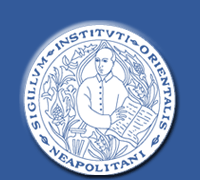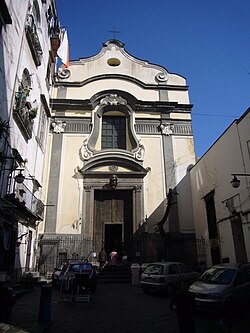
GiacomoBarozzida Vignola, often simply called Vignola, was one of the great Italian architects of 16th century Mannerism. His two great masterpieces are the Villa Farnese at Caprarola and the Jesuits' Church of the Gesù in Rome. The three architects who spread the Italian Renaissance style throughout Western Europe are Vignola, Serlio and Palladio. He is often considered the most important architect in Rome in the Mannerist era.

Quartieri Spagnoli is a part of the city of Naples in Italy. The Neapolitan language is stronger here than anywhere else. The area, encompassing c. 800,000 square metres, consists of a grid of around eighteen streets by twelve, including a population of some 14,000 inhabitants.

Ferdinando Fuga was an Italian architect who was born in Florence, and is known for his work in Rome and Naples. Much of his early work was in Rome, notably, the Palazzo della Consulta (1732–7) at the Quirinal, the Palazzo Corsini (1736–54), the façade of the Santa Maria Maggiore (1741–3), and the Church of Sant'Apollinare (1742–8). He later moved to Naples and notably designed the Albergo de'Poveri (1751–81), the façade of the Church of the Gerolamini, and that of the Palazzo Giordano.

Giugliano in Campania, also known simply as Giugliano, is a city and comune in the Metropolitan City of Naples, Campania, Italy. As of 2017, it had some 124,000 inhabitants, making it the most populated Italian city that is not a provincial capital.

Lorenzo de Caro was an Italian painter, active in the late Baroque style in his native city of Naples.
Carosino is a town and comune in the province of Taranto, in the northern Salento, part of the Apulia region of southeast Italy. Carosino was historically an Arbëreshë settlement.

Sant'Ambrogio di Torino is a comune (municipality) in the Metropolitan City of Turin in the Italian region Piedmont, located about 25 km west of Turin in the Susa Valley.

Sant'Anna dei Lombardi,, and also known as Santa Maria di Monte Oliveto, is an ancient church and convent located in piazza Monteoliveto in central Naples, Italy. Across Monteoliveto street from the Fountain in the square is the Renaissance palace of Orsini di Gravina.

Via dei Tribunali is a street in the old historic center of Naples, Italy.

Astolfo Petrazzi (1583–1665) was an Italian painter of the Baroque period, active mainly in his hometown of Siena, but also Spoleto and Rome. He was a pupil of mainly Francesco Vanni, but also worked under Ventura Salimbeni and Pietro Sorri. He died in Siena.

Via del Babuino is a street in the historic centre of Rome (Italy), located in the rione Campo Marzio. It connects Piazza del Popolo to Piazza di Spagna and is part of the complex of streets known as Tridente.

Sant'Angelo a Nilo is a Roman Catholic church located on the Decumano Inferiore in Naples, Italy. It stands diagonally across from San Domenico Maggiore in Naples. It is known for containing the monumental Renaissance-style tomb of Cardinal Rainaldo Brancacci by Donatello and Michelozzo, one of the major sculptural works in the city.

University of Naples "L'Orientale" is a university located in Naples, Italy. Founded in 1732 by Matteo Ripa, it is organized in three Departments. The oldest school of Sinology and Oriental Studies of the European continent is the main university in Italy specializing in the study of non-European languages and cultures, with research and studies agreements with universities all over the world. It is one of the top universities in the world regarding Asian cultures and languages.

The Basilica of San Pietro ad Aram is a Baroque-style, Roman Catholic church in Naples, Italy. It is located about a block from the church of the Santissima Annunziata on Corso Umberto I.

San Giovanni a Mare is a church in Naples, Italy; located near the docks, not far from the church of Sant'Eligio Maggiore.

The Basilica of San Giovanni Maggiore is a church in Largo San Giovanni Maggiore in central Naples, Italy.

The church of Santi Severino e Sossio and the annexed monastery are located on via Bartolommeo Capasso in Naples, Italy.

The Palazzo Orsini di Gravina is a Renaissance-style palace on number 3 Via Monteoliveto, in the San Lorenzo quarter of Rione San Giuseppe-Carità, of central Naples, Italy. Since 1940, it has housed the Faculty of Architecture of the University of Naples. It is located across the street and a few doors north of the sleek and modern Palazzo delle Poste. Across the street at the north end of the palace, is the Piazza Monteoliveto with its Fountain and the church of Sant'Anna dei Lombardi.

Geronimo Gerardi (1595-1648) was a Flemish artist active in Italy. He was born Guilliam Walsgart or Hyeronimus Gerards.

Portrait of Cardinal Alessandro Farnese is a c. 1545 – 46 oil on canvas three-quarter-length portrait of Alessandro Farnese the Younger (1520-1589) by Titian, now in the Museo nazionale di Capodimonte in Naples.





















